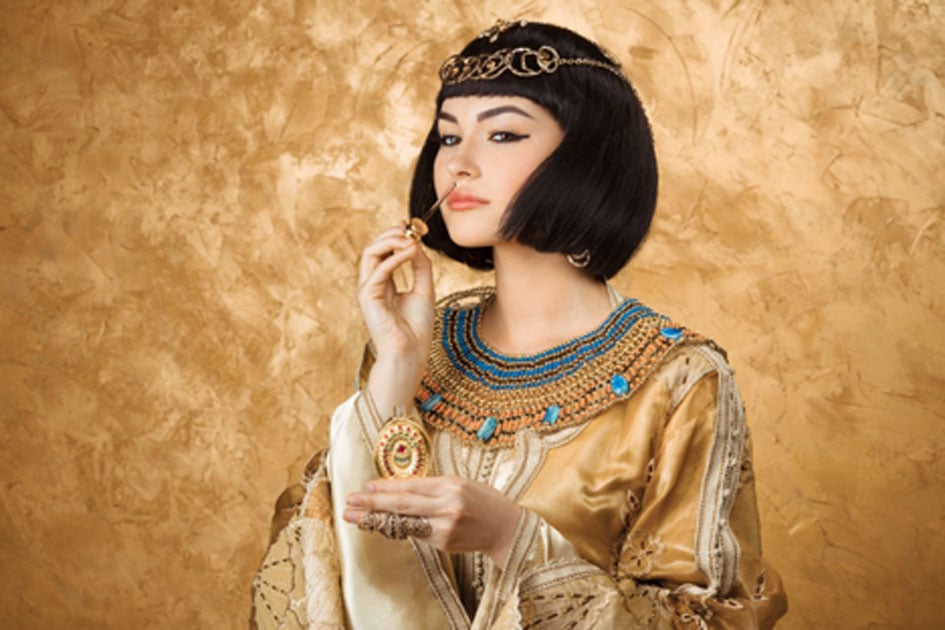Cleopatra’s Perfume Recreated – A Scent That Once Masked The Odor Of Sour Donkey Milk!
Two professors in Hawaii have recreated a range of ancient perfumes including the scent worn by the legendary Cleopatra, Queen of Egypt, which are all on exhibition in a National Geographic exhibit.
Evidence of perfume production has been found in Syria dating back 7,000 years and hieroglyphics tell us that Ancient Egyptians began manufacturing perfume around 3,000 BC as a ritualistic offering and for application within entombment and mummification procedures.
According to Ancient Egypt Online the first reference to ‘Kyphi’ or temple incense, is in the Pyramid Texts which date to the 5th and 6th dynasties of the Old Kingdom (2686 BC - 2181 BC). While these texts do not provide the actual recipe for Kyphi, nor do they list any of the original ingredients, they do inform that Kyphi was one of the luxuries that self-respecting pharaohs used in the journey into the afterlife.
New Aromas Using Ancient Scents
Professor Robert Littman and adjunct professor Jay Silverstein of the University of Hawai’i at Mānoa run the Tell Timai Project which excavates the ancient Egyptian city Thmuis (Tell Timai) in the Nile Delta. During the Ptolemaic period (305 to 30 BC) Thmuis succeeded Djedet as the capital of Lower Egypt; in the 4th century it was an important Roman city and after the AD 642 Muslim invasion of Egypt it was renamed Al-Mourad.

Perfume bottle in the shape of a hes-vase inlaid with the figure of a princess. Period: New Kingdom, Amarna Period (Metropolitan Museum of Art)
The first phase of the Tell Timai Project revealed tangible archaeological evidence to support ancient Greek records stating Thmuis was an ancient center of perfume production. A report in University of Hawai’i News says “a vast complex of third century BC kilns was discovered” which had fired “imported clays to manufacture fine lekythoi or perfume bottles”.
A glass manufacturing kiln from the Roman period was also discovered and this is thought to “represent the transition from ceramic to the ‘unguentaria’, which are small glass perfume jars.” The archaeologists also found amphora (clay containers) in the manufacturing area and chemical analysis is being conducted to see if there may be identifiable traces of any of the liquids and tinctures once produced at the site.

Egyptians wearing perfume cone. The cones would melt and cause fragrance to soak their wigs. painting from Tomb at Thebes dates to about 1275 BC. (CC BY 2.0)
Cleopatra’s Obsession With Natural Scents
Having found formulas for ancient Thmuis perfumes in Greek texts, Professors Littman and Silverstein approached German researchers Dora Goldsmith and Sean Coughlin, who are leading specialists on the composition and production of ancient perfumes. Talking about the process of recreating the lost perfumes, Littman told reporters at University of Hawai’i News “What a thrill it is to smell a perfume that no one has smelled for 2,000 years and one which Cleopatra might have worn.”
Cleopatra was obsessed with scents and on Saturday 27th August I published a YouTube video in which I first collect roses and then recreate ancient Egyptian Rose water. While I suggest you use Rose water as a conditioner to make your “hair glow in a new three-dimensional way”, in Shakespeare’s Antony and Cleopatra, Act II, Scene II we learn Cleopatra’s bed chamber and many of her public spaces were “half-a-meter deep in rose petals” and that she “soaked her cedar barge sails in rose water” so that her impending arrival would be announced with a waft of beauty in the air.
- Capturing Scents, Not Tears: Debunking the Myth of Tear Catchers
- Searching for the Lost Tomb of Antony and Cleopatra
- The Forgotten Cleopatra: Searching for Cleopatra the Alchemist and Her Golden Secret

The making of lily perfume. Limestone, fragment from the decoration of a tomb, 4th dynasty of Egypt-(2500s BC). (Louvre Museum)
Her obsession with smelling good suggests the Ancient Egyptian queen might have had something to hide, and I don’t think we need look much further that this McGill article which discusses her habit of bathing in “sour donkey milk.” Believing she would reduce her wrinkles, the sugar lactose in donkey milk converts into lactic acid (by bacteria) which when applied to the skin caused “the surface layer to peel off, leaving new smoother blemish-free skin underneath.”
This is all well and good for one’s appearance, but bathing “sour donkey milk” I ask you! That lady must have stank to high-heaven and all the roses in ancient Iran (a lot) would have done little to mask her brutally equestrian odor.
The “Queens Of Egypt” Exhibit
The archaeological research of professors Littman and Silverstein and the recreated ancient fragrances of professors Goldsmith and Coughlin have been brought together by the National Geographic Society (NGS) in Washington, D.C. in what they describe as “a new and innovative exhibition on the “Queens of Egypt.” Open until 15 September the exhibition promises to stimulate visitors in that NG say “it incorporates cutting edge research, virtual reality experience, and the fragrances of the Queens of Egypt.”
Hopefully they have left the rotting donkey milk for another time.
Top image: Cleopatra’s use of perfume was famous. Source: EmotionPhoto / Adobe Stock
By Ashley Cowie




















Comments
There were no white-skinned people living in Africa. If you are not depicting people of color in Africa, your site is fraudulent.
Shakespeare is a fantasy writer. Antony and Cleopatra was a drama with functionally no historical grounding of details and it is extraordinarily unlikely that he had any actual Egyptian sources for that, just Roman. Are we to expect that Theseus was a real person who is accurately depicted in Midsummer Night's Dream?